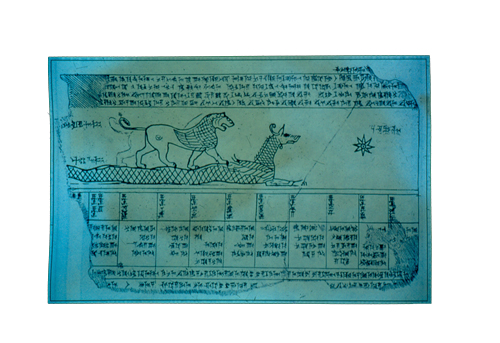Robes and Fabrics - The Mantle of Roger II
Red silk with golden embroidery
Size: 345x146 cm
Origin and time: Palermo, 1133
Kunsthistorische Museum, Schatzkammer / Treasury of the Museum of Fine Arts in Vienna
Inv. No. XIII 14
Much literature has already been published about the so-called Coronation Mantle of Roger II, a magnificent 900 year old treasure adorned with oriental symbols and an Arabic inscription. Produced in the royal workshops in Palermo, this mantle is one of the most important showpieces exhibited in the Treasury of the Museum of Fine Arts in Vienna.
The outer side of this semi-circular mantle, held together with an enamel clasp, is made of red silk twill onto which golden thread embroidery was couched, and all objects presented were outlined in pearls. The theme proper is mirror-symmetrical, a stylised palm tree with a lion riding on a camel on either side of it. When the bearer of the mantle closes it above the breast, the two lions face each other. Both the lions and the camels are presented in shapes clearly illustrating their Zodiac constellations “al-asad (leo) and aš-šuğā (hydra)“. The respective stars are represented by precious stones (which explains the 11 kilos this robe weighs). The constellation of the lion is the same worldwide, while the camel does not have a sign in western astronomy. The Arabs, however, used the constellation of the hydra which for them was a mythical animal of great importance and have turned it into a camel as shown on the slides below. While the triumph of the lion over the camel is a widespread interpretation of the figures depicted on the mantle, in the Muslim world, the killing of such a precious mount would not find such acceptance. Roger, although a Catholic, was known for his magnanimous attitude towards the Arabs and was most favourably inclined towards Islam. Having ordered the robe at a workshop employing Muslim staff might explain his choice of the two motifs represented on the mantle: the mirror-symmetrical representation of constellations (to the left as seen in the firmament, to the right as shown on a globe) to demonstrate that a ruler carries part of the universe on his shoulders on the one hand, the need of a ruler to be carried through his realm in impressive and reliable fashion on the other.
In contrast to the singular large motif on the outer side, representing Fatimid tradition, the lining shows small motifs only: the tree of life (arbour vitae) in multiple repetitions: vividly coloured human figures, dragons, birds, cirri and ornaments are assembled on the golden basic fabric. This iconography probably dates back to Coptic-Arab textile art.
How did this robe become part of the German Emperors´ treasury?
Roger II had a daughter Konstanze, who was married to Henry VI, son of Friedrich I, Barbarossa. As sole heir she took all her father´s treasures with her to Germany, where her son, Friedrich II inherited the mantle and wore it at his coronation. Following an interlude when Karl IV (of Bohemia) had the treasures transferred to Prague and subsequently on to Nuremberg, Friedrich III of the House of Hapsburg had them brought to Vienna, from where Napoleon ordered the treasury to be retransferred to Nuremberg. Josef II (son of Maria Theresia) had wisely transferred the robe to Regensburg earlier on and had it returned to Vienna later on. However, Hitler ordered the entire treasury to be stored at Nuremberg from where the American forces eventually restored it to Vienna in 1946.
Sources:
Abd ar-rahmān as-sūfī: kitāb suwar al-kawākib (A book illustrating the stars). A manuscript dating back to the 10th century AD, published in Hyderabad 1954; Robert H. Van Gent: “Stars and Constellations in Islamic Science and Culture”. Institute for History and Foundations of Mathenmatics and the Natural Sciences, University of Utrecht; Hatice Skarits: „Der Krönungsmantel des Heiligen Römischen Reiches“ Published in: Der STERNENBOTE, Österreichische Astronomische Monatsschrift, 639/2009-10: 188;





